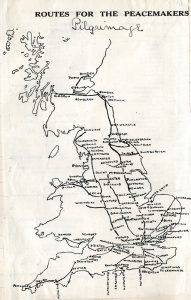In May 1926 the Peacemakers’ Pilgrimage, organised by the Women’s International League for Peace and Freedom, set out along seven different routes from all corners of the country, heading for London. Meetings were held in towns and villages along the way, helping the message of peace to reach more people. The first contingent arrived in London on 18 June and the next day all the pilgrims converged on four rallying points around Hyde Park before setting out in a procession for the final mass demonstration.
An eye-witness description reveals that women of all walks of life took part in the Pilgrimage:
‘Here were women of the Guild House in blue cassocks and white collars, bearing their banners aloft: behind them walked members of the League of Nations Union, with bannerettes, representing various countries of the world … there was a group of miners wives. At the head of each procession rode a woman in a Madonna blue cloak on a white horse.’ (1)
The pilgrimage culminated in a pageant in Hyde Park and from 22 platforms speakers from all political parties supported the aims of the demonstration. Special peace services were held in hundreds of churches and the press gave the pilgrimage significant favourable coverage.
References/Further Reading:
(1) Cited in C. Lewis, 2013. The Great Peace Pilgrimage of 1926. LSE Library Blog.


